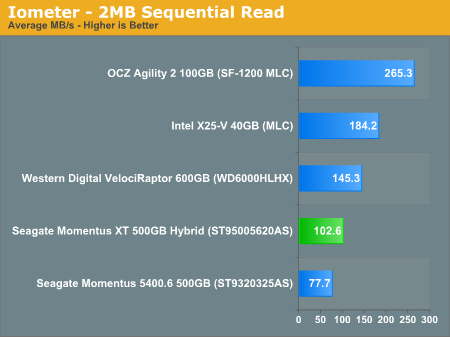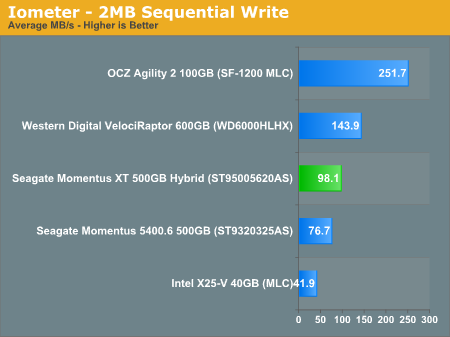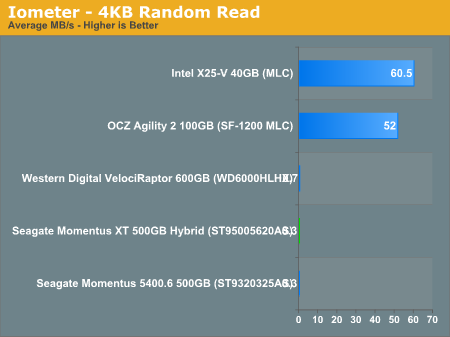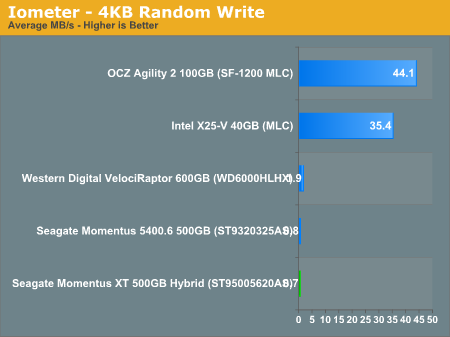Seagate's Momentus XT Reviewed, Finally a Good Hybrid HDD
by Anand Lal Shimpi on May 24, 2010 9:31 AM EST- Posted in
- Storage
- SSDs
- Seagate
- Momentus XT
- Hybrid Drive
- SSHDs
Sequential Read/Write Speed
Using the 6-22-2008 build of Iometer I ran a 3 minute long 2MB sequential test over the entire span of the drive. The results reported are in average MB/s over the entire test length:

Both sequential read and write speed are improved over the 5400.6 but we're still not in VelociRaptor territory. The X25-V is cripped in its write performance by comparison but most other SSDs do very well.

Random Read/Write Speed
This test reads/writes 4KB in a completely random pattern over an 8GB space of the drive to simulate the sort of random access that you'd see on an OS drive (even this is more stressful than a normal desktop user would see). I perform three concurrent IOs and run the test for 3 minutes. The results reported are in average MB/s over the entire time.

Random read/write performance is abysmal. You can't really make out the numbers here but that's 0.7MB/s for reads and 0.3MB/s for writes compared to 40MB/s+ for the SSDs. It's the poor random access performance that ultimately prevents the Momentus XT from feeling like an SSD most of the time.











120 Comments
View All Comments
7Enigma - Tuesday, May 25, 2010 - link
" With So much RAM we could cache those Random Read Write Directly to RAM. Why would we need a Hybrid HDD?"I think what is confusing you is the differences between RAM and Flash. RAM stores data while constantly consuming power. When the power is cut the data is lost. Flash retains the data when power is cut. It is also much slower than RAM in terms of read/write performance (RAM drives have been a geeks dream for a couple years now but the costs are still quite prohibitive. It seemed like we were getting closer to being possible for the average tech geek without a trust fund when RAM prices were so low last year but due to the recent price hikes it's again out of reach).
So to answer your question IMO this drive is designed for a laptop computer where you only have a single HD bay and power consumption is a significant issue. In a laptop situation it is not practical to use RAM as a cache since you'd be draining the battery even when the computer is off.
janus-cassandra - Monday, May 24, 2010 - link
Anand I think you are missing important advantages of and SSD in a laptop, (1) lower power consumption than that of a traditional drive with spinning platters and more importantly (2) decreased susceptibility to catastrophic data loss due to a hard drive crash when one's computer is dropped or undergoes any other rapid acceleration and deceleration. As this last consideration happens all to often with laptops, it seems to me that an SSD drive should be standard issue in most, if not all laptops. A hybrid drive will not provide this protection.johndoe74 - Tuesday, May 25, 2010 - link
you guys should have included a 500 GB 7200 rpm drive in there as well (or instead of the 5400 rpm) for the sake of comparison. a 5400 rpm drive is kind of a dinosaur these daysKlinky1984 - Tuesday, May 25, 2010 - link
Hybrid drives are probably one of the most pointless technologies of the last give years. I don't see how they will ever amount to much. The only way they will is if the cache becomes massive, about the size of what SSDs are now and has a smarter caching algorithm. I can do the same thing that they are doing with their hybrid drive with windows already. Just plop in 8GB of RAM & set windows to prefer system caching. Bam, whatever ram you're not using is used as a cache for reads & that memory can always be reclaimed by programs needing to use it.Hybrid drives only have the negatives of SSD(cost) with the negatives of HDDs(speed, reliability, noise, power consumption), without much of the benefit. Whoever thought "hey, put some flash on it and then we'll let the HDD spin down!', great idea when the hard drive takes probably about 0.5 seconds in good scenario to boot back up, but some could take a couple seconds. Not a good user experience. Boot times look nice, but who spends their time rebooting their computer all day? Is 30 extra seconds booting going to be worth the added cost?
Maybe Seagate should focus efforts on a "dual drive" where you get a 32GB SSD & a 500GB HDD combined into a a single 2.5" form factor. That would let people use the 32GB as their OS drive & the 500GB for their large files, etc.
mpx999 - Tuesday, May 25, 2010 - link
Actually best of high-end disk arrays of today use Flash as a cache. For example NetApp uses module called PAM II which is up to 512MB of SLC used a cachehttp://www.netapp.com/us/products/storage-systems/...
Oracle storage systems, especially 7000 series, also use Flash Caches known as L2ARC i ZIL.
http://sun.systemnews.com/articles/134/4/OpenStora...
So flash cache is a proven technology! They just need to go above 4GB to get better results.
hadifa - Tuesday, May 25, 2010 - link
Normal HDD write speed, and very good read speed the second time for small files.For that purpose, this drive is very good and the 4GB is not that bad because only small files are cached, though I would have hoped for at least double that. There is no mention of how small the file needs to be in order to be cached, or maybe I misunderstood the article.
This drive faces two challenges:
1- Just one NAND chip so no parallel read so limited read speed of about 30-40 GB p/s
2- The NAND is used only for reads, so the write speed is not accelerated.
I'm not going to fuss a lot about the write, but I hope they make a version with say 2*4GB chips and a controller to raid the reads, I would be happy to shell some extra hard earned money for that.
Klinky1984 - Tuesday, May 25, 2010 - link
It's not a "Smart Hybrid" like what was being proposed earlier, with Windows Vista/7 being able to identify it as being a hybrid drive and optimize your experience by placing the most used files into the flash cache. It's as "Dumb Hybrid" essentially the flash is just another layer on top of the normal in-memory buffer. Play a large video file a couple times and all your program files are flushed from the cache, just due to the amount of data going back and forth and since the cache is "dumb" it doesn't know if the sectors it's caching are part of an important document or some image from Temporary Internet Files.It may not be bad if you have small needs, but I think a lot of enthusiasts would be disappointed with it.
zodiacfml - Tuesday, May 25, 2010 - link
I agree with all his comments.This is a good hybrid HDD, but to laptops only since the price premium is $50 to $90 which is quite expensive. For the same price or little more for the desktop, we can buy an SSD and HDD with a lot more performance and capacity.
For his recommendation, this is still a good drive for notebook users looking for more capacity and performance since SSD's, though perfect for the application, is too expensive and lack capacity. Don't doubt the reliability since writes and storage are done on the platters, same reliability with mechanical HDD.
Lastly, I think the 4GB size of SLC NAND flash is chosen as the least (expensive SLC) amount of memory for the most often used files or blocks (typical usage - OS, common Apps). Adding more or making it twice bigger will only benefit users with more and varied apps. It can be done with dual channel but the performance improvement will not be as great. Simply, Seagate just wants more margins and less trouble.
Chloiber - Tuesday, May 25, 2010 - link
4GB is more than enough!On a regular desktop system, you can store ALL files up to 256k on 4GB...and for bigger files, a HDD isn't much slower than a single NAND module.
ABR - Tuesday, May 25, 2010 - link
I hate to burst peoples' bubbles here but how many of the files slowing down boot are going to stay in the 4GB cache? Assuming you spend more of your time running your computer and working with other files that get loaded and unloaded more often than core startup components (somewhat questionable with Windows, I realize ;), then the only time you'll see boot speedup is in artificial tests. Of course, that's the way you should want it...